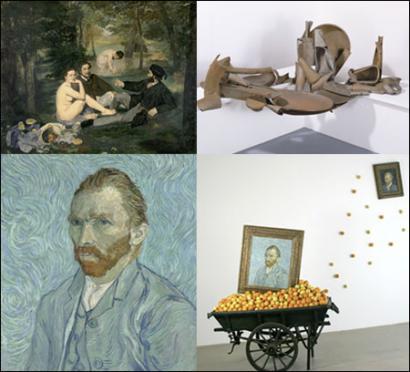
LEFT TO RIGHT, FROM TOP TO BOTTOM: EDOUARD MANET (1832-1883)Le déjeuner sur l'herbe, 1863
Oil on cloth 208 x 264,5 cm, musée d'Orsay © Patrice Schmidt, Paris, musée d'Orsay
ANTHONY CARO, Déjeuner sur l'herbe II,1989 Steel 97 x 187 x 252 cm Londres, Tate Gallery
© Photo John Riddy
VINCENT VAN GOGH (1853-1889) Autoportrait, 1887 Oil on cloth 44,1 x 35,1 cm Paris, musée d'Orsay -
BRACO DIMITRIJEVIC Triptychos post historicus or Van Gogh at last in Paradise Installation at musée
d'Orsay, Paris 2005 © Braco Dimitrijevic / Vincent Godeau |
|
MUSÉE D'ORSAY
Entrance through the square
1, rue de la Légion d’Honneur, 75007 PARIS
INFORMATION:
Tel. +33 01 40 49 48 00
Site: www.musee-orsay.fr
OPENING HOURS:
Every day, except on monday, from 10:00 AM to 6:00 PM,
thursday from 10:00 AM to 9:45 PM
sunday from 9:00 AM to 6:00 PM
ADMISSION FEES:
Museum: Full rate: 7,50€ Concessions and sunday: 5,50€
Free admissions: under 18, and every first sunday of the month
CURATORSHIP:
Serge Lemoine, Président du musée d’Orsay,assisted by Olivier Gabet, conservateur au musée d'Orsay.
PRESS CONTACTS
Amélie Hardivillier: +33 (0) 1 40 49 48 56
Patricia Oranin: +33 (0) 1 40 49 47 42
E-mail: presse@musee-orsay.fr

|
Since the fall of 2004, the Musée d’Orsay is inviting three times a year two contemporary artists, one French and the other foreign, of different generations and whose styles and techniques totally differ from one another, to present one of their works, in relation with a work from the museum equally chosen by them. Their creation is put face to face with the one it refers to, in order to underline to what point the art of the XIXth century and beginning of the XXth century is a source of inspiration for artists living in the XXIst century. The «duo» this autumn brings together Antony Caro and Braco Dimitrijevic.
The Déjeuner sur l’herbe
One of the greatest living sculptors, Anthony Caro has constantly been fascinated by the work of his contemporaries – Henry Moore, whom he worked for as an assistant, Morris Louis and David Smith – as well as by the works of the classic Antiquity, Goya, Van Gogh and Cézanne, and, in particular, Manet. Anthony Caro chose to be in correspondence with the latter, invited by the museum
The concept of the table
By associating elegance of the line and imposing complexity, his Déjeuner sur l’herbe II 1989, Collection of the Tate Gallery, London – draws its inspiration indeed from Manet’s work which created a scandal in its time. It was the famous art critic Michael Fried who incited Caro to make his work evolve by promoting the concept of the table, which then allowed him to free his sculptures from the constraint of the pedestal and to spread them out in forms that are freer and more dynamic. His Déjeuner leans on an angle, deploys its overlapping steel forms in space along a subtle composition, in response to Manet’s choice to pose his characters in the landscape of the painting.
Van Gogh’s Self-portrait
To Braco Dimitrijevic, the public, mobilized by the artist’s interventions, really signs the work, or, on the contrary, if for example it is being photographed, becomes the essential object of the representation. This leads him to think of the role the work of art has in the museum’s context and in front of the public. He pursues what he deems has turned the History of Art into a source of errors, be it one single error: the weight of contingency and of chance, the narrowness of temporal and geographic contexts, the logic of the ends triumphing over the causes. His work, without a defined style and openly conceptual, therefore fits into what he calls post-History.
The Triptychos Post Historicus
At the musée d’Orsay, he suggests an intervention in the same style as his series of Triptychos Post Historicus, elaborated since the 70s in the major museums in the world. The series definitely associates three elements, a product of vegetable origin, a manufactured product and a work generally recognized as a “master piece”. The latter, here, is represented by Van Gogh’s Self-portrait, following the works by Rubens, Hals, Delacroix, Turner, Kandinsky, Modigliani, Matisse and Malevitch which he has already used in his own.
PUBLICATIONS :
Édouard Manet/Anthony Caro, French English, 160x240, 64 p., Papercover, Co-publication Éditions Hazan/Musée d'Orsay 13 €
Vincent Van Gogh/Dimitrijevic, French English, 160x240, 64 p., Papercover, Co-publication Éditions Hazan/Musée d'Orsay 13 €
|








